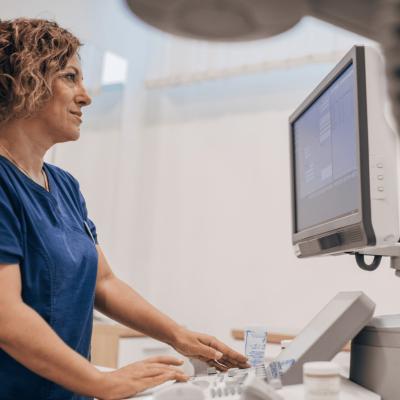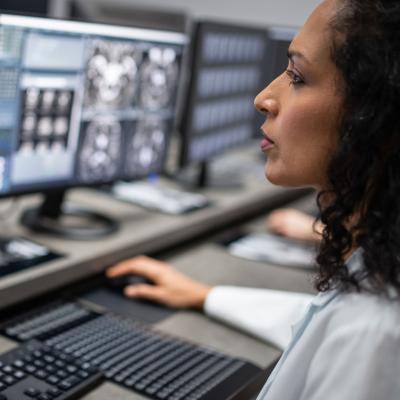- AdventHealth University

Radiologic technologists play a vital role in diagnosing and treating various medical conditions. If the idea of working with cutting-edge technology and contributing to patient care excites you, pursuing a career as a radiologic technologist, sometimes referred to as radiology technician or rad tech, may be the perfect fit for you.
Learning the requirements and path is the first step to your career as a radiologic technologist. Let's explore the criteria to taking that first step in your career.
What Do Radiologic Technologists Do?
You may be eager to get an early start on the roadmap to becoming a radiology tech. Before diving into the specific requirements you first need to know the day-to-day responsibilities and duties associated with the role to see if it suits your interests:
- Utilize imaging equipment such as X-rays, CT scans, and MRIs to produce diagnostic images.
- Maintain and calibrate imaging equipment to ensure they’re accurate and safe for patients.
- Assist radiologists and physicians in interpreting images and diagnosing medical conditions.
- Ensure patient safety and comfort during imaging procedures.
- Keep and create detailed records of procedures and patient information.
Education and Training
Becoming a radiologic technologist requires the following education requirements:
- Get a high school diploma or equivalent: The journey to becoming a radiologic technologist begins with a high school diploma or GED equivalent. General STEM courses in math, biology, chemistry, and physics will provide you with a solid foundation to hone your skills.
- Complete a degree program: Pursue an accredited radiography or imaging sciences program, which are typically associate degrees. These programs cover topics such as anatomy, patient care, radiation physics, and image acquisition and evaluation that will provide you with the fundamentals of radiology.
- Clinical experience: Most radiologic technology programs include clinical internships or rotations, providing you with the most valuable form of education: hands-on experience in a health care setting. These experiences allow you to apply all of your classroom knowledge in real-world scenarios under the guidance of experienced technologists.
- Bachelor's Degree: While an associate degree is the minimum qualifications required for entry-level positions, a bachelor's degree in imaging sciences will set you apart. A bachelor's degree can offer additional opportunities for career advancement and allow you to specialize in your field.
Certification and Licenses
The American Registry of Radiologic Technologists (ARRT) offers national certification for radiologic technologists. Candidates must pass the ARRT exam to get this certification, which assesses knowledge and skills. Eligibility requirements may vary but typically include completing an accredited program and meeting ethical standards.
In addition to the ARRT certification, many states may require you to obtain further certifications or education. Some require radiologic technologists to obtain a state license to practice. Requirements vary by state and often include passing a state-specific radiology exam or fulfilling continuing education requirements.
Specialization and Career Advancement
Radiology offers various specialization opportunities, allowing radiology technologists to focus on specific areas such as MRI, CT, mammography, interventional or cardiovascular imaging. Pursuing additional certifications in these specialties can enhance career prospects and earning potential.
Some radiology technologists may choose to pursue advanced degrees or certifications to expand their career opportunities. Options include a bachelor's or master's degree in radiologic science, health care administration, or related fields.
As radiology technologists gain experience, they may take on leadership roles, such as lead technologist, department supervisor, or educator. Developing strong communication, problem-solving, and leadership skills can pave the way for advancement within the field.
Job Outlook
The demand for radiologic technologists is expected to grow in the coming years, driven by advancements in medical imaging technology and an aging population. Job opportunities are available in hospitals, imaging centers, doctor’s offices, and other common health care settings.
Getting Started on Your Path to Becoming a Radiologic Technologist
Becoming a radiology technologist requires dedication, education, and a passion for helping others. By completing a radiologic technology program, obtaining certification, and pursuing specialization opportunities, potential candidates can embark on a fulfilling career in this dynamic and essential field of health care. With continued advancements in medical imaging technology, radiologic techs will remain integral to patient care and diagnosis in the years to come.
If you are interested in a career in radiology, AdventHealth University offers an Associate of Science in Radiography program as well as our Bachelor of Science in Nuclear Medicine Technology program.
Recommended Readings
Benefits of Interventional Radiology
Nine Key Figures in Radiology
How to Become A Radiology Director
Sources
Radiologic and MRI Technologists." Bureau of Labor Statistics, U.S. Department of Labor


